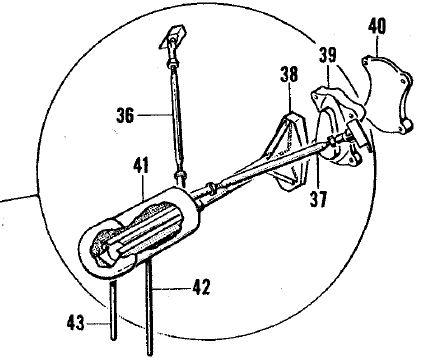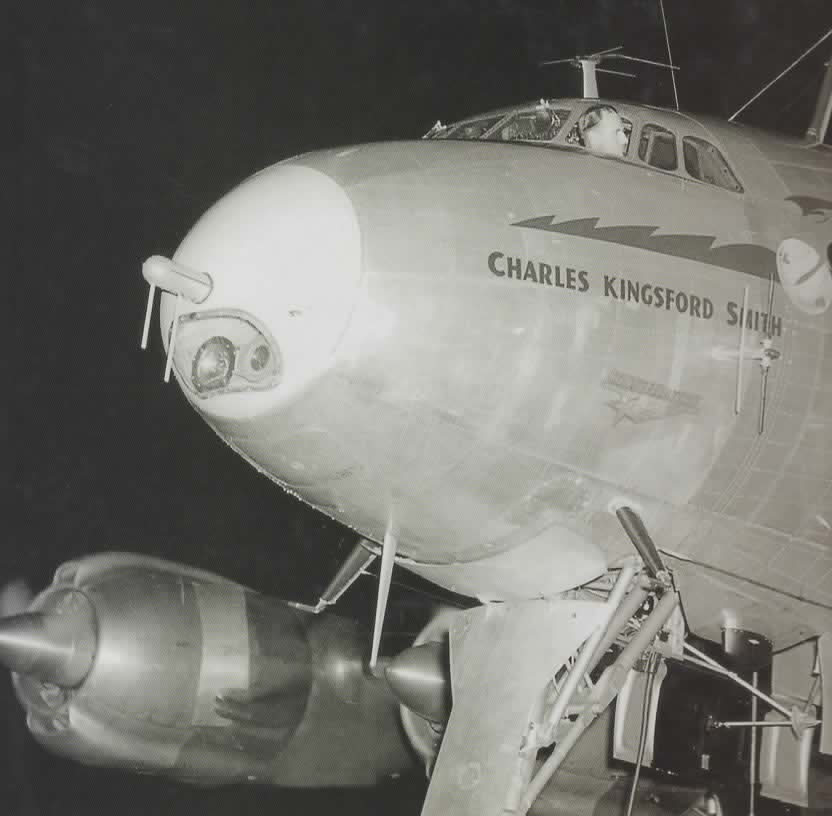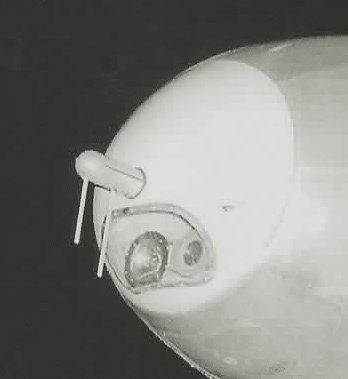Constellation Antenna
Looks more like one of the original mk1 chemtrailing dispenser nozzles - the front rod is a vortex generator to ensure turbulent flow over the dispenser tube to get optimum trail dispersion.
PDR
PDR
Join Date: Mar 2007
Location: USofA
Posts: 1,235
Likes: 0
Received 0 Likes
on
0 Posts
The probe/antenna is only visible on early shots of the original Qantas 749 Constellations VH-EAA to EAD:

Later photos of the same aircraft don't feature it.
I still think it's an ice detector.

Later photos of the same aircraft don't feature it.
I still think it's an ice detector.

As I heard it, that odd array is part of a primitive ILS antenna. Probably LLZ.
Never have seen its like and never saw any patched holes in any L-749 I worked (multiple operators) where it would have been. Might have been unique to Qantas.
thread drift - Note the two lamps, one clear the other red. They were also on L-1049 until the wx radar was installed. The clear lamp one can understand. it put light on the ground in front of you while taxiing. But what was the red lamp for? Joke was it was a "passing light" you flashed when overtaking another aircraft. Might have been hard for the other aircraft to see it. Never found out its purpose. Anyone know?
thread drift - Note the two lamps, one clear the other red. They were also on L-1049 until the wx radar was installed. The clear lamp one can understand. it put light on the ground in front of you while taxiing. But what was the red lamp for? Joke was it was a "passing light" you flashed when overtaking another aircraft. Might have been hard for the other aircraft to see it. Never found out its purpose. Anyone know?
Red passing lights were a feature on many aircraft in that era. My WW2 T-6C had one in the landing light recess in the leading edge of the wing..
https://aviation.stackexchange.com/q...-t-6-for/43451
https://aviation.stackexchange.com/q...-t-6-for/43451
Radio Altimeter aerial?
Could it be part of the Radio Altimeter (not Rad Alt) for Pressure Pattern Nav?
Pressure Pattern Flying, IIRC from conversations with JDW 'George' Washington and 'Slim' Rosier who both knew about these things was....
...long range Nav typically used by Qantas in the mid latitudes and low levels. Think Hobart to Auckland 8,000 - 12000ft. The difference between Departure and Destination QFE was plugged into a formula (other variables being distance, radio altitude and change of latitude, I think) to come up with a constant heading to fly.....the Connie would fly at a constant Radio altitude (thus the altitude would vary) and a single heading was flown to give the maximum tail wind component for the sector.
Pressure Pattern Flying, IIRC from conversations with JDW 'George' Washington and 'Slim' Rosier who both knew about these things was....
...long range Nav typically used by Qantas in the mid latitudes and low levels. Think Hobart to Auckland 8,000 - 12000ft. The difference between Departure and Destination QFE was plugged into a formula (other variables being distance, radio altitude and change of latitude, I think) to come up with a constant heading to fly.....the Connie would fly at a constant Radio altitude (thus the altitude would vary) and a single heading was flown to give the maximum tail wind component for the sector.
TACAN or DME?
That looks like the TACAN (VOR/DME) or DME antennas found on aircraft such as I used to work on. I am more used to seeing them under one wing, but that looks like the antenna: spacing and size are about right.
It's been a long time...
It's been a long time...
How can radio discern your altitude when you're at 8,000 ft plus ?
TACAN - the polarisation would be right, both the bearing part and the distance part being vertical but it's a military aid why have it on a civil aircraft.
Join Date: Jun 2003
Location: Australia
Posts: 469
Likes: 0
Received 0 Likes
on
0 Posts
I have a friend who was a Qantas outstations engineer on these aircraft but he is on holidays right now. However while I wait his return I am wondering is it an Australian DME antenna.
Looking at all the photos that I have of Connies of that era I agree its exclusive to Qantas 749s so it has to be a system that was exclusively Australian. Australia at that time had invented and operated its own DME system. So maybe that's it.
I'll update when I find my friend
Wunwing
Looking at all the photos that I have of Connies of that era I agree its exclusive to Qantas 749s so it has to be a system that was exclusively Australian. Australia at that time had invented and operated its own DME system. So maybe that's it.
I'll update when I find my friend
Wunwing
Thread Starter
My thanks to Peter Clukey at Lockheed Martin for providing the definitive answer:

The receiving antenna can be seen under the name "Smith" in this image. This type of antenna was common to many other types.

Thanks to all who contributed.
It is a Type 308 transmitting antenna for a Rebecca (BABS) homing system. The 649/749 Constellation parts catalog lists the two stub antennas on the nose protrusion as being two separate units, one being a Type 308 Transmitter and the other being a Type 15 Director. See items 42 and 43 on the following diagram.

The receiving antenna can be seen under the name "Smith" in this image. This type of antenna was common to many other types.

Thanks to all who contributed.
Thought it might be :-)
Evil device: the transmitter was a power oscillator (!!) tuned with a motorised Lecher line (go on, get the manuals out and look them both up, you won't find such evil devices anywhere these days...)

Packed a wallop: about 250 watts or 1 kW peak, I seem to remember. And "reliability" was not in their lexicon.
John,
This what I love about PPRuNe. I keep learning obscure trivia. I had never heard of a Lecher line:
https://en.m.wikipedia.org/wiki/Lecher_lines
How big was the Lecher line equipment? Was it built in or plugged in as test equipment?
This what I love about PPRuNe. I keep learning obscure trivia. I had never heard of a Lecher line:
https://en.m.wikipedia.org/wiki/Lecher_lines
How big was the Lecher line equipment? Was it built in or plugged in as test equipment?
Join Date: Jun 2003
Location: Australia
Posts: 469
Likes: 0
Received 0 Likes
on
0 Posts
There appears to be 2 vertically orientated side antennae as well as the nose one. Photos that I have show them on both port and starboard sides of the cockpit.
The question is why did Qantas alone have this device given at the time they were known as Qantas Empire Airways and did nearly everything in lockstep with BOAC. I can't locate any photos of BOAC aircraft with these devices
Wunwing
The question is why did Qantas alone have this device given at the time they were known as Qantas Empire Airways and did nearly everything in lockstep with BOAC. I can't locate any photos of BOAC aircraft with these devices
Wunwing
I42 you have read the wiki I expect. In this application they would be used as in the last line, not for measuring wavelength but as a tuned circuit in the oscillator. Not vast ¼ λ at 170 -230 Mhz not a lot and inside the box I would think.
That is a good question, must have been some strange Australian reason as, as far as I am concerned it is purely a military aid. I never did it on my training at college, maybe I'm too old I was only licensed in 1972.
The question is why did Qantas alone have this device given at the time they were known as Qantas Empire Airways and did nearly everything in lockstep with BOAC
That is a good question, must have been some strange Australian reason as, as far as I am concerned it is purely a military aid. I never did it on my training at college, maybe I'm too old I was only licensed in 1972.




